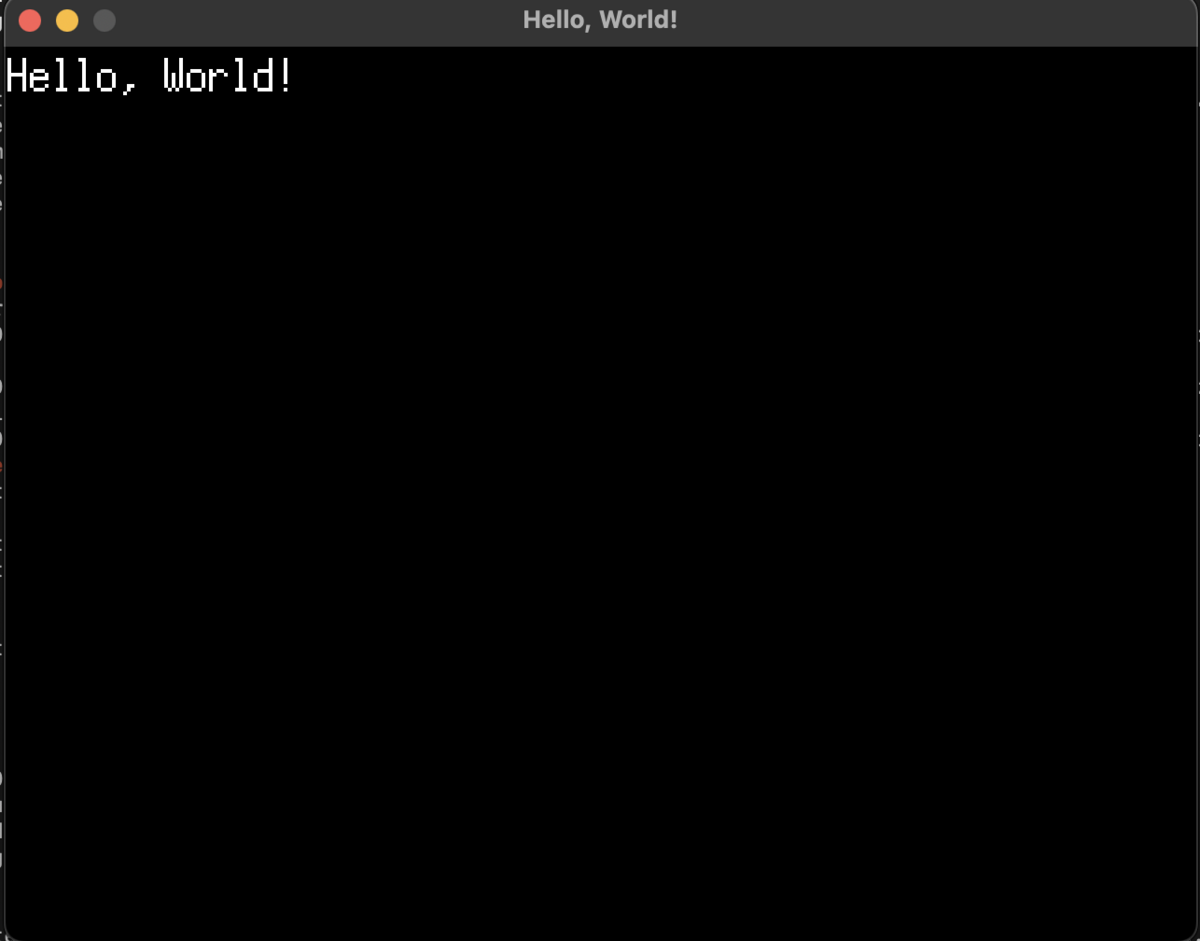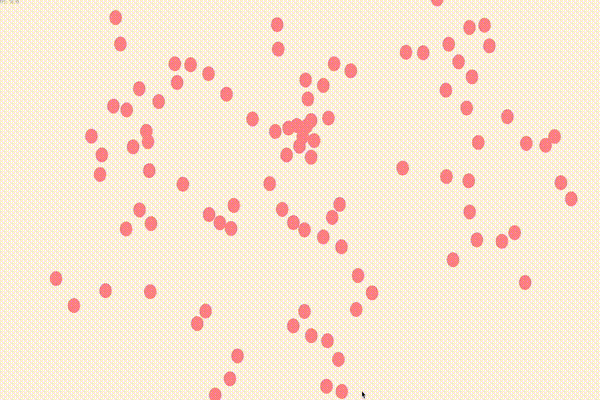Boids Flockingの実装を通して、Go製のゲームエンジンEbitengineに入門します。
はじめに
Go製のゲームエンジンEbitengineというものを見つけて面白そうだったので、取り急ぎ何か作ってみようと思いました。
以前に他のゲームエンジンで実装したことのあるBoids Flockingを実装し、Ebitengineに入門していきたいと思います。
Go製ゲームエンジンの"Ebitengine"というものを見かけて面白そうだったので、入門にBoids Flockingを実装してみた.
— BioErrorLog (@bioerrorlog) August 9, 2023
コードはこちらに公開してますhttps://t.co/omJOpJxgsS pic.twitter.com/dRaELijjNr
# 作業version Go: 1.20.7 Ebitengine: v2.5.6
Ebitengineとは
Ebitengineは、
- Go製のオープンソース2Dゲームエンジン
- マルチプラットフォーム対応 (Nintendo Switchもサポート)
- ミニマムなAPI
- 「全ては矩形画像である」- 矩形画像から矩形画像へ描画でゲームを構成する
という特徴を持ったゲームエンジンです。
設計思想はEbitengine作者様の記事にわかりやすく解説されていますので、ご興味があれば一読をお勧めします。
- ゲームエンジンはアートである - 8 年以上自作ゲームエンジンをメンテし続けている話|Hajime Hoshi
- 既に拡張性のある無料のゲームエンジンがある中,なぜ時間と労力をかけて独自のゲームエンジンを開発していらっしゃるのでしょうか? | mond
Ebitenginで作られた有名どころのゲーム事例としては、
などがあります。
どちらもOdencatさんからのゲーム(Nintendo Switchにも移植されてる)なのですが、OdencatさんがEbitengineを採用するに至った経緯や、このツールの活用方法を語った下記の資料も面白いのでおすすめです。
www.slideshare.net
今回作ったもの: Boids Flocking
Boids Flockingは、鳥の群れの動きをシミュレートする人工生命モデルです。 "Bird-oid"「鳥っぽいもの」という意味で、Boidsと呼ばれています。
Boids Flockingのアルゴリズム自体の説明については過去記事で整理しましたので、そちらを参照ください。
最終的なコードはGitHubに配置していますので、以降はこのコードを元にしながらポイントを整理していきます: github.com
Boids Flockingを実装する
最小構成: Hello, World!
Boids Flockingの実装に移る前に、まずはEbitengine製ゲームにおける最小構成を確認しておきます。
// main.go package main import ( "log" "github.com/hajimehoshi/ebiten/v2" "github.com/hajimehoshi/ebiten/v2/ebitenutil" ) type Game struct{} func (g *Game) Update() error { return nil } func (g *Game) Draw(screen *ebiten.Image) { ebitenutil.DebugPrint(screen, "Hello, World!") } func (g *Game) Layout(outsideWidth, outsideHeight int) (screenWidth, screenHeight int) { return 320, 240 } func main() { ebiten.SetWindowSize(640, 480) ebiten.SetWindowTitle("Hello, World!") if err := ebiten.RunGame(&Game{}); err != nil { log.Fatal(err) } }
Game structを用意し、3つの関数Update Draw Layoutを実装して上記のようにRunGameに渡してあげれば、ゲームを実行することができます。
Updateはフレームごとに呼び出される処理で、主にゲームロジックの実行/ゲームステートの更新を担わせます。Drawもフレームごとに呼び出される処理で、こちらは描画処理を担います。Layoutはゲームのスクリーンサイズを定義します。
go run main.goでゲームを実行できます。

Boids Flockingを実装する時も同じく、ロジックをUpdateに実装し、Drawで描画処理を実装する、という形をとっていきます。
ディレクトリ構成
Boids Flockingを実装するにあたって、main.goに全コードを書くと流石に読みにくくなってしまうので、下記のようなディレクトリ構成にしてみました。
# treeコマンド結果から抜粋
.
├── go.mod
├── go.sum
├── main.go
├── boids
│ ├── boid.go
│ └── game.go
└── vector
├── vec2.go
└── vec2_test.go
エントリーポイントとなるmain.go、ゲームロジックを実装するboidsパッケージ、あとは二次元ベクトル操作処理を実装するvectorパッケージです。
ベクトル処理は既存のライブラリを使った方が良いのでしょうが、今回は諸々の入門として自分で書いています。
main.goは、boidsパッケージで定義するgameロジックを呼び出すだけにとどめています。
package main import ( "log" "github.com/bioerrorlog/boids-ebitengine/boids" "github.com/hajimehoshi/ebiten/v2" ) func main() { game, err := boids.NewGame() if err != nil { log.Fatal(err) } ebiten.SetWindowSize(boids.ScreenWidth, boids.ScreenHeight) ebiten.SetFullscreen(true) ebiten.SetWindowTitle("Boids") if err := ebiten.RunGame(game); err != nil { log.Fatal(err) } }
Ref. GitHub - bioerrorlog/boids-ebitengine at aa86fe9fe9d4a8626ef1d652338a5dce1e7a5f84
ゲームロジックの実装
こちらが大本となるゲームロジックです。
package boids import ( "fmt" "image/color" "math/rand" "github.com/bioerrorlog/boids-ebitengine/vector" "github.com/hajimehoshi/ebiten/v2" "github.com/hajimehoshi/ebiten/v2/ebitenutil" ) const ( ScreenWidth = 1920 ScreenHeight = 1080 boidCount = 100 ) type Game struct { boids []*Boid } func NewGame() (*Game, error) { g := &Game{ boids: make([]*Boid, boidCount), } for i := range g.boids { g.boids[i] = NewBoid( rand.Float64()*ScreenWidth, rand.Float64()*ScreenHeight, vector.Vec2{X: ScreenWidth / 2, Y: ScreenHeight / 2}, ) } return g, nil } func (g *Game) Update() error { for _, b := range g.boids { b.Update(g.boids) } return nil } func (g *Game) Draw(screen *ebiten.Image) { // Backgroud screen.Fill(color.RGBA{255, 245, 228, 0xff}) // Boids for _, b := range g.boids { b.Draw(screen) } // Debug fps := fmt.Sprintf("FPS: %0.2f", ebiten.ActualFPS()) ebitenutil.DebugPrint(screen, fps) } func (g *Game) Layout(outsideWidth, outsideHeight int) (screenWidth, screenHeight int) { return ScreenWidth, ScreenHeight }
NewGame関数からGame structを外部から取得できるようにしています。
Game structは後述するBoidを配列で保持しており、UpdateではBoidのUpdate関数を呼び出します。
Drawでは描写を行っており、順番に背景描画、Boidsの描画、デバッグ(fps表示)描画を行っています。
Boids Flockingロジックの実装
次はGameから呼び出しているBoid個々のロジックの実装です。
package boids import ( "image/color" "math/rand" "github.com/bioerrorlog/boids-ebitengine/vector" "github.com/hajimehoshi/ebiten/v2" ev "github.com/hajimehoshi/ebiten/v2/vector" ) const ( moveSpeed = 20 perceptionRadius = 100 steerForce = 1 alignmentForce = 0.1 cohesionForce = 0.05 separationForce = 0.3 centralizationForce = 0.3 centralizationForceRadius = 200 ) type Boid struct { position, velocity, targetCenter vector.Vec2 } func NewBoid(x, y float64, targetCenter vector.Vec2) *Boid { return &Boid{ position: vector.Vec2{X: x, Y: y}, velocity: vector.Vec2{X: rand.Float64()*2 - 1, Y: rand.Float64()*2 - 1}, targetCenter: targetCenter, } } func (b *Boid) Draw(screen *ebiten.Image) { ev.DrawFilledCircle(screen, float32(b.position.X), float32(b.position.Y), 20, color.RGBA{255, 148, 148, 0xff}, true) } func (b *Boid) Update(boids []*Boid) { neighbors := b.getNeighbors(boids) alignment := b.alignment(neighbors) cohesion := b.cohesion(neighbors) separation := b.separation(neighbors) centering := b.centralization() b.velocity = b.velocity.Add(alignment).Add(cohesion).Add(separation).Add(centering).Limit(moveSpeed) b.position = b.position.Add(b.velocity) } // 以下略
NewBoidで初期化されたBoidを返し、Drawで描画、UpdateでBoidsアルゴリズムを実行しています。
Boidsアルゴリズムとして、
alignment: 近隣のboidsと同じ方向に進もうとする力cohesion: 近隣のboids集合の中心地に向かおうとする力separation: 近隣のboidsと近づきすぎないよう距離をとる力
の3つを掛け合わせています。
それとは別に、boids達が画面外に行ってしまわないよう画面中心へと向かう力centralizationも追加しています。
それぞれの力についての詳しい実装はここでは取り上げない(上記コード// 以下略部分)ので、ご興味ある方はソースコードをご覧ください。
あとはconstで定めた各パラメータの微修正を繰り返し、なんとなく滑らかでいい感じになるようにしました。 出来上がったBoidsたちの動きは、なかなか気に入っています。
Vector処理の実装
上記Boidの実装では、自前のvector処理を利用しています。 (本来はライブラリを使った方が良いと思いますが、せっかくの入門なので自分で書いています)
package vector import "math" type Vec2 struct { X, Y float64 } func (v Vec2) Add(other Vec2) Vec2 { return Vec2{v.X + other.X, v.Y + other.Y} } func (v Vec2) Sub(other Vec2) Vec2 { return Vec2{v.X - other.X, v.Y - other.Y} } func (v Vec2) Mul(scalar float64) Vec2 { return Vec2{v.X * scalar, v.Y * scalar} } func (v Vec2) Div(scalar float64) Vec2 { return Vec2{v.X / scalar, v.Y / scalar} } func (v Vec2) Length() float64 { return math.Sqrt(v.X*v.X + v.Y*v.Y) } func (v Vec2) Normalize() Vec2 { length := v.Length() if length != 0 { return Vec2{v.X / length, v.Y / length} } return Vec2{0, 0} } func (v Vec2) Limit(max float64) Vec2 { if v.Length() > max { return v.Normalize().Mul(max) } return v } func (v Vec2) DistanceTo(other Vec2) float64 { diff := v.Sub(other) return diff.Length() }
Boidsアルゴリズムで使うことになる、二次元ベクトル操作の実装です。
ゲームロジックや描画の実装にはなかなかテストを書きにくいこともありますが、このような純粋なGoコードであれば普通にテストが書けます:
package vector import ( "math" "testing" ) func TestVec2_Add(t *testing.T) { tests := []struct { name string v Vec2 other Vec2 want Vec2 }{ {"basic add", Vec2{3, 4}, Vec2{1, 2}, Vec2{4, 6}}, {"add with zero", Vec2{3, 4}, Vec2{0, 0}, Vec2{3, 4}}, {"add with negative values", Vec2{3, 4}, Vec2{-1, -2}, Vec2{2, 2}}, {"add with same values", Vec2{3, 4}, Vec2{3, 4}, Vec2{6, 8}}, {"add with floating values", Vec2{3.5, 4.5}, Vec2{1.5, 2.5}, Vec2{5, 7}}, {"add with mix of positive and negative", Vec2{3, -4}, Vec2{-1, 2}, Vec2{2, -2}}, } for _, tt := range tests { t.Run(tt.name, func(t *testing.T) { if got := tt.v.Add(tt.other); got != tt.want { t.Errorf("Vec2.Add() = %v, want %v", got, tt.want) } }) } } func TestVec2_Sub(t *testing.T) { tests := []struct { name string v Vec2 other Vec2 want Vec2 }{ {"basic subtraction", Vec2{3, 4}, Vec2{1, 2}, Vec2{2, 2}}, {"subtract with zero", Vec2{3, 4}, Vec2{0, 0}, Vec2{3, 4}}, {"subtract negative values", Vec2{3, 4}, Vec2{-1, -2}, Vec2{4, 6}}, {"subtract same values", Vec2{3, 4}, Vec2{3, 4}, Vec2{0, 0}}, {"subtract floating values", Vec2{3.5, 4.5}, Vec2{1.5, 2.5}, Vec2{2, 2}}, {"subtract mix of positive and negative", Vec2{3, -4}, Vec2{-1, 2}, Vec2{4, -6}}, {"subtract resulting in negative", Vec2{3, 4}, Vec2{5, 6}, Vec2{-2, -2}}, } for _, tt := range tests { t.Run(tt.name, func(t *testing.T) { if got := tt.v.Sub(tt.other); got != tt.want { t.Errorf("Vec2.Sub() = %v, want %v", got, tt.want) } }) } } // 以下略
テストを実行し、ALL PASSすれば安心です。
$ go test -v ./... ? github.com/bioerrorlog/boids-ebitengine [no test files] ? github.com/bioerrorlog/boids-ebitengine/boids [no test files] === RUN TestVec2_Add === RUN TestVec2_Add/basic_add === RUN TestVec2_Add/add_with_zero === RUN TestVec2_Add/add_with_negative_values === RUN TestVec2_Add/add_with_same_values === RUN TestVec2_Add/add_with_floating_values === RUN TestVec2_Add/add_with_mix_of_positive_and_negative --- PASS: TestVec2_Add (0.00s) --- PASS: TestVec2_Add/basic_add (0.00s) --- PASS: TestVec2_Add/add_with_zero (0.00s) --- PASS: TestVec2_Add/add_with_negative_values (0.00s) --- PASS: TestVec2_Add/add_with_same_values (0.00s) --- PASS: TestVec2_Add/add_with_floating_values (0.00s) --- PASS: TestVec2_Add/add_with_mix_of_positive_and_negative (0.00s) # 中略 PASS ok github.com/bioerrorlog/boids-ebitengine/vector (cached)
ゲーム側の実装はこれで完成です。
CIの実装
最後にGitHub Actionsを設定して、コードの静的解析やbuild、testの実行を自動化させます。
name: Test on: - push - pull_request jobs: test: runs-on: ubuntu-latest steps: - name: Checkout uses: actions/checkout@v2 - name: Setup Go uses: actions/setup-go@v3 with: go-version: '1.20' - name: Install dependencies run: | sudo apt-get update sudo apt-get install -y libasound2-dev libgl1-mesa-dev libxcursor-dev libxi-dev libxinerama-dev libxrandr-dev libxxf86vm-dev - name: Run golangci-lint uses: golangci/golangci-lint-action@v3 with: version: latest - name: Vet run: go vet ./... - name: Build run: go build -v ./... - name: Test run: go test -v ./...
必要なライブラリをインストールしたのち、静的解析(golangci-lintとgo vet)、go build、go testを実行しています。
Install dependenciesではいろんなものをインストールさせていますが、これをしないとubuntuではgo vetが落ちるので注意です。
(インストールするライブラリは本家Ebitengineのworkflowを参考にしました)
おわりに
Go製のゲームエンジンEbitengineで、Boids Flockingを実装してみました。
個人的にはこれまで、
- 自分でゲーム作るならシンプルな2Dゲーム一択 (2Dゲーム好きだし、3D酔いしやすいので)
- そうなると、既存のゲームエンジンはぶっちゃけ機能が過剰
- 何かにハマったときの切り分けがつらい (徐々にモチベに悪影響)
- (もちろん使いこなせば高い生産性が出せるのかもしれないが...)
という思いを抱いてきたので、APIがシンプルなEbitengineは触っていて心地良かったです。
以上、ちょっとした一例としてどなたかの参考になれば幸いです。
[関連記事]
参考
GitHub - hajimehoshi/ebiten: Ebitengine - A dead simple 2D game engine for Go
Ebitengine - A dead simple 2D game engine for Go
ebiten package - github.com/hajimehoshi/ebiten/v2 - Go Packages
ゲームエンジンはアートである - 8 年以上自作ゲームエンジンをメンテし続けている話|Hajime Hoshi
既に拡張性のある無料のゲームエンジンがある中,なぜ時間と労力をかけて独自のゲームエンジンを開発していらっしゃるのでしょうか? | mond
Real-world game development with Ebitengine - How to make the best-selling Go game | PPT
GitHub - bioerrorlog/boids-ebitengine: Boids flocking simulation with Ebitengine
